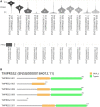Prostate adenocarcinoma and COVID-19: The possible impacts of TMPRSS2 expressions in susceptibility to SARS-CoV-2
- PMID: 33609069
- PMCID: PMC8013364
- DOI: 10.1111/jcmm.16385
Prostate adenocarcinoma and COVID-19: The possible impacts of TMPRSS2 expressions in susceptibility to SARS-CoV-2
Abstract
TMPRSS2 (OMIM: 602060) is a cellular protease involved in many physiological and pathological processes, and it facilitates entry of viruses such as SARS-CoV-2 into host cells. It is important to predict the prostate's susceptibility to SARS-CoV-2 infection in cancer patients and the disease outcome by assessing TMPRSS2 expression in cancer tissues. In this study, we conducted the expression profiles of the TMPRSS2 gene for COVID-19 in different normal tissues and PRAD (prostate adenocarcinoma) tumour tissues. TMPRSS2 is highly expressed in normal tissues including the small intestine, prostate, pancreas, salivary gland, colon, stomach, seminal vesicle and lung, and is increased in PRAD tissues, indicating that SARS-CoV-2 might attack not only the lungs and other normal organs, but also in PRAD cancer tissues. Hypomethylation of TMPRSS2 promoter may not be the mechanism for TMPRSS2 overexpression in PRAD tissues and PRAD pathogenesis. TMPRSS2 expresses eleven isoforms in PRAD tissues, with the TMPRSS2-001 isoform expressed highest and followed by TMPRSS2-201. Further isoform structures prediction showed that these two highly expressed isoforms have both SRCR_2 and Trypsin (Tryp_SPc) domains, which may be essential for TMPRSS2 functional roles for tumorigenesis and entry for SARS-CoV-2 in PRAD patients. Analyses of functional annotation and enrichment in TMPRSS2 showed that TMPRSS2 is mostly enriched in regulation of viral entry into host cells, protein processing and serine-type peptidase activity. TMPRSS2 is also associated with prostate gland cancer cell expression, different complex(es) formation, human influenza and carcinoma, pathways in prostate cancer, influenza A, and transcriptional misregulation in cancer. Altogether, even though high expression of TMPRSS2 may not be favourable for PRAD patient's survival, increased expression in these patients should play roles in susceptibility of the SARS-CoV-2 infection and clinical severity for COVID-19, highlighting the value of protective actions of PRAD cases by targeting or androgen-mediated therapeutic strategies in the COVID-19 pandemic.
Keywords: COVID-19; SARS-CoV-2; TMPRSS2 gene; prostate adenocarcinoma; susceptibility.
© 2021 The Authors. Journal of Cellular and Molecular Medicine published by Foundation for Cellular and Molecular Medicine and John Wiley & Sons Ltd.
Conflict of interest statement
None.
Figures





Similar articles
-
Impact of TMPRSS2 Expression, Mutation Prognostics, and Small Molecule (CD, AD, TQ, and TQFL12) Inhibition on Pan-Cancer Tumors and Susceptibility to SARS-CoV-2.Molecules. 2022 Nov 1;27(21):7413. doi: 10.3390/molecules27217413. Molecules. 2022. PMID: 36364238 Free PMC article.
-
Covid-19 pathogenesis in prostatic cancer and TMPRSS2-ERG regulatory genetic pathway.Infect Genet Evol. 2021 Mar;88:104669. doi: 10.1016/j.meegid.2020.104669. Epub 2020 Dec 7. Infect Genet Evol. 2021. PMID: 33301988 Free PMC article. Review.
-
Computational analysis of TMPRSS2 expression in normal and SARS-CoV-2-infected human tissues.Chem Biol Interact. 2021 Sep 1;346:109583. doi: 10.1016/j.cbi.2021.109583. Epub 2021 Jul 17. Chem Biol Interact. 2021. PMID: 34284028 Free PMC article.
-
Comprehensive analysis of two potential novel SARS-CoV-2 entries, TMPRSS2 and IFITM3, in healthy individuals and cancer patients.Int J Biol Sci. 2020 Sep 30;16(15):3028-3036. doi: 10.7150/ijbs.51234. eCollection 2020. Int J Biol Sci. 2020. PMID: 33061814 Free PMC article.
-
Gene of the month: TMPRSS2 (transmembrane serine protease 2).J Clin Pathol. 2020 Dec;73(12):773-776. doi: 10.1136/jclinpath-2020-206987. Epub 2020 Sep 1. J Clin Pathol. 2020. PMID: 32873700 Review.
Cited by
-
COVID-19 and Prostatitis: A Review of Current Evidence.Diseases. 2024 Jul 15;12(7):157. doi: 10.3390/diseases12070157. Diseases. 2024. PMID: 39057128 Free PMC article. Review.
-
A review on human reproductive systems encountering with the severe acute respiratory syndrome coronavirus 2 infection.Int J Reprod Biomed. 2023 Feb 8;21(1):1-16. doi: 10.18502/ijrm.v21i1.12661. eCollection 2023 Jan. Int J Reprod Biomed. 2023. PMID: 36875501 Free PMC article. Review.
-
HSPA6 and its role in cancers and other diseases.Mol Biol Rep. 2022 Nov;49(11):10565-10577. doi: 10.1007/s11033-022-07641-5. Epub 2022 Jun 6. Mol Biol Rep. 2022. PMID: 35666422 Review.
-
The analysis of cathepsin L that mediates cellular SARS-CoV-2 infection leading to COVID-19 in head and neck squamous cell carcinoma.Front Immunol. 2023 May 23;14:1156038. doi: 10.3389/fimmu.2023.1156038. eCollection 2023. Front Immunol. 2023. PMID: 37292206 Free PMC article.
-
Impact of TMPRSS2 Expression, Mutation Prognostics, and Small Molecule (CD, AD, TQ, and TQFL12) Inhibition on Pan-Cancer Tumors and Susceptibility to SARS-CoV-2.Molecules. 2022 Nov 1;27(21):7413. doi: 10.3390/molecules27217413. Molecules. 2022. PMID: 36364238 Free PMC article.
References
-
- Paoloni‐Giacobino A, Chen H, Peitsch MC, Rossier C, Antonarakis SE. Cloning of the TMPRSS2 gene, which encodes a novel serine protease with transmembrane, LDLRA, and SRCR domains and maps to 21q22.3. Genomics. 1997;44:309‐320. - PubMed
-
- Tomlins SA, Rhodes DR, Perner S, et al. Recurrent fusion of TMPRSS2 and ETS transcription factor genes in prostate cancer. Science. 2005;310:644‐648. - PubMed
-
- Ko CJ, Huang CC, Lin HY, et al. Androgen‐induced TMPRSS2 activates matriptase and promotes extracellular matrix degradation, prostate cancer cell invasion, tumor growth, and metastasis. Can Res. 2015;75:2949‐2960. - PubMed
Publication types
MeSH terms
Substances
Grants and funding
- 00031726/Special Training Program for Young Science and Technology Talents from Southwest Medical University
- 2018LZXNYD-YL01/The Joint Research Foundation of Luzhou City and Southwest Medical University
- 81672887/National Natural Science Foundation of China
- 82073263/National Natural Science Foundation of China
- 30371493/National Natural Science Foundation of China
LinkOut - more resources
Full Text Sources
Other Literature Sources
Medical
Miscellaneous

